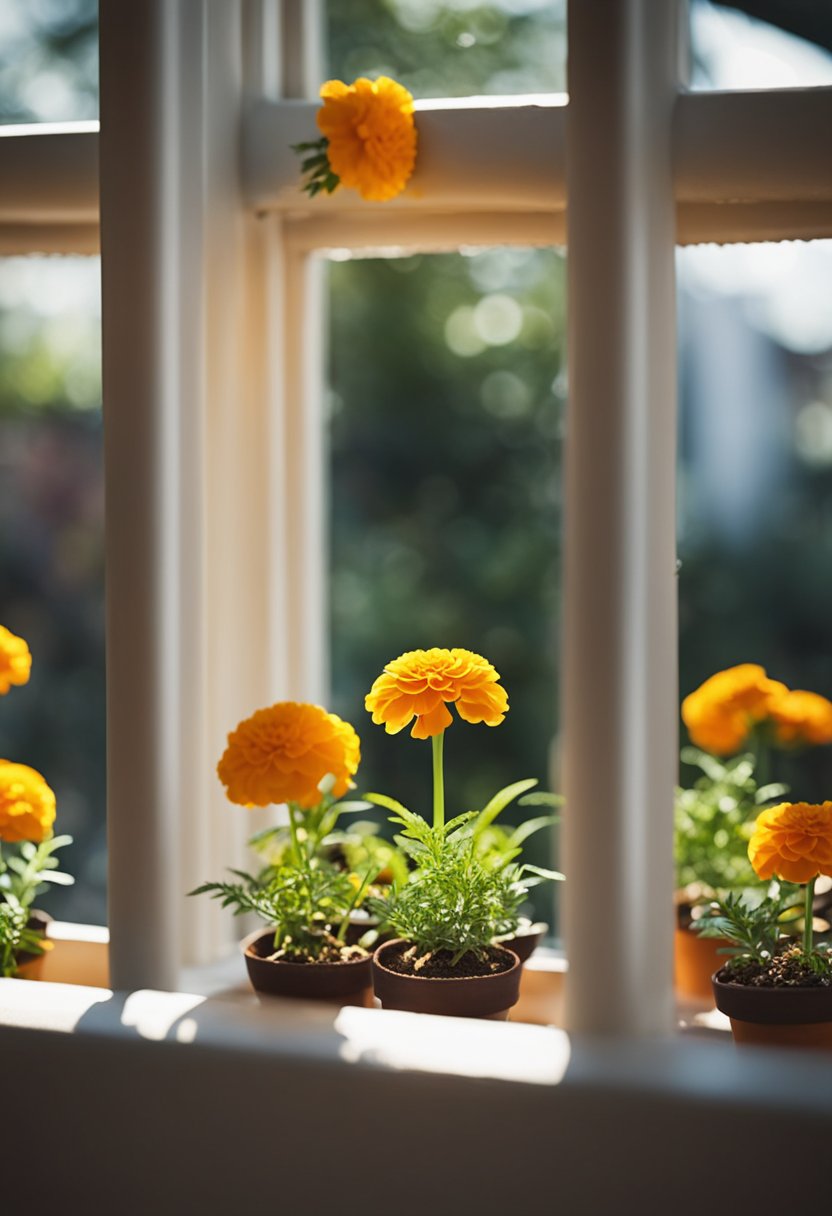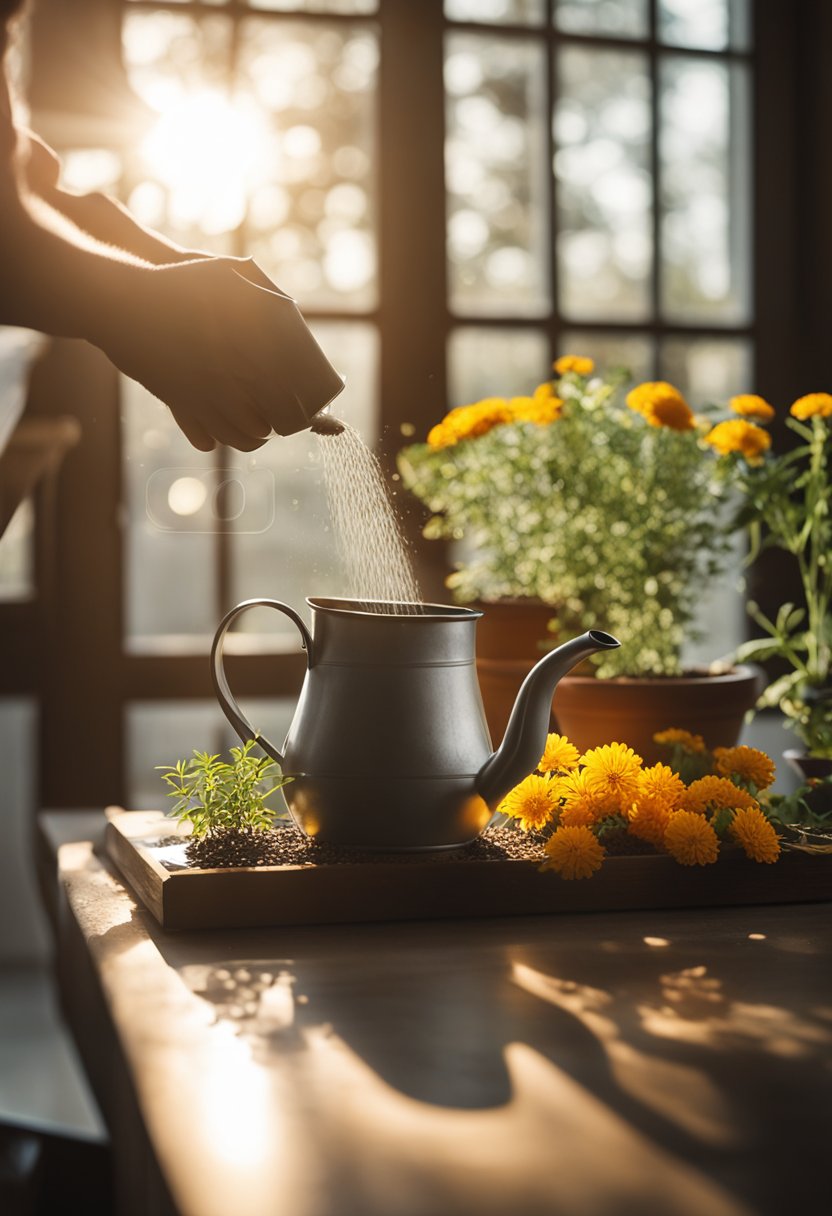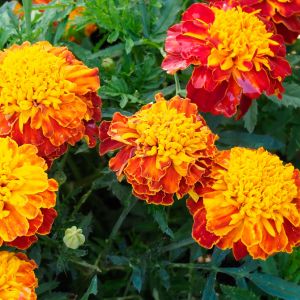Do you want to add some color to your balcony or patio? Marigolds are a great choice for container gardening. These cheerful flowers are easy to grow and care for, and they come in a range of colors from bright yellow to deep orange and red.
This post may contain affiliate links.
In this article, you’ll learn how to grow marigolds in pots, so you can enjoy their beauty all season long.
The first step to growing marigolds in pots is to choose the right container. You’ll want a pot that’s at least 6-8 inches deep and wide enough to accommodate the mature size of your marigold plant.
Make sure the pot has drainage holes to prevent water from pooling at the bottom, which can lead to root rot. You can use plastic, ceramic, or terra cotta pots, but keep in mind that terra cotta pots will dry out faster than other materials.
Next, you’ll need to choose the right soil for your marigolds. These plants prefer well-draining soil that’s rich in organic matter. You can use a commercial potting mix or make your own by combining equal parts of compost, peat moss, and perlite or vermiculite.
Avoid using garden soil, which can be too heavy and may contain pests or diseases. In the next section, we’ll talk about how to plant your marigolds in pots.
Related Article: What to Plant in April: A Guide to Spring Gardening
Choosing the Right Pot
When it comes to growing marigolds in pots, choosing the right pot is crucial to ensure their healthy growth. Here are some factors to consider when selecting a pot:
Pot Size
The size of the pot you choose depends on the type of marigold you want to grow. Dwarf varieties require a pot that is at least 6 inches in diameter and 6 inches deep.
For larger varieties, you will need a pot that is at least 8 inches in diameter and 8 inches deep. Keep in mind that marigolds have a shallow root system, so a pot that is too deep may cause the soil to retain too much moisture.
Related Article: Are Zinnias Edible? A Friendly Guide to Zinnia Flowers as Food
Drainage Considerations
Marigolds require well-draining soil to thrive, so it’s essential to choose a pot with adequate drainage. Look for pots with drainage holes at the bottom to allow excess water to drain out. You can also add a layer of gravel or broken pottery at the bottom of the pot to improve drainage.
Material Types
Pots come in various materials, including plastic, terracotta, and ceramic. Plastic pots are lightweight and easy to move around, but they may not be as durable as other materials.
Terracotta pots are porous and allow for good airflow, but they can dry out quickly. Ceramic pots are attractive and come in many colors and designs, but they can be heavy and prone to cracking.

Selecting Marigold Varieties
When selecting marigold varieties, it’s important to consider your growing conditions and personal preferences. Here are some popular marigold varieties to consider:
French Marigolds
French marigolds are known for their compact size and abundant blooms. They come in a variety of colors, including yellow, orange, red, and bi-colors. French marigolds are perfect for small containers and edging.
Related Article: What to Plant in March: A Guide to Spring Planting
African Marigolds
African marigolds are larger than French marigolds and produce big, bold blooms in shades of yellow, orange, and gold. They are perfect for larger containers and garden beds. African marigolds also make great cut flowers.
Signet Marigolds
Signet marigolds are smaller than French marigolds and have delicate, lacy foliage. They produce small, edible flowers in shades of yellow and orange. Signet marigolds are perfect for small containers and herb gardens.
When selecting marigold varieties, consider the size of your container, the amount of sunlight your plants will receive, and your personal preferences for color and bloom size. With the right variety, you can enjoy beautiful marigold blooms all season long.

Potting Mix and Soil Preparation
When it comes to growing marigolds in pots, the right potting mix and soil preparation can make all the difference. Here are some tips to ensure your marigolds thrive:
Potting Mix
Marigolds thrive in well-draining soil, which means your potting mix should be light and airy. You can use a commercial potting mix or make your own by mixing equal parts of peat moss, vermiculite, and perlite. This will provide good drainage and aeration for your marigolds.
Soil Preparation
Before planting your marigolds, prepare the soil in your pot. Start by filling the pot with the potting mix, leaving about an inch of space at the top.
Then, add a slow-release fertilizer to the mix and mix it in well. This will provide your marigolds with the nutrients they need to grow strong and healthy.
Next, water the soil until it is evenly moist. This will help settle the soil and ensure that it is evenly distributed throughout the pot. Let the soil drain for a few minutes before planting your marigolds.
By using the right potting mix and preparing your soil properly, you can give your marigolds the best possible start and ensure that they thrive in their new home.
Related Article: Annuals; 5 Easy to Grow Flowers
Planting Marigolds in Pots
Marigolds are the perfect flowers to brighten up any garden or patio. They are easy to grow in pots and add a splash of color to any space. Here are some tips on how to plant marigolds in pots.
Seed Sowing
The first step in planting marigolds in pots is to sow the seeds. Fill the pot with potting soil, leaving about an inch of space at the top. Sow the seeds about half an inch deep and cover them with soil. Water the soil gently and keep it moist until the seeds germinate.
Once the seeds have germinated, thin them out so that each plant has enough space to grow. Keep the soil moist, but not too wet, and give the plants plenty of light.
Transplanting Seedlings
When the seedlings are about two inches tall, it’s time to transplant them into larger pots. Fill the new pot with potting soil and make a hole in the center. Carefully remove the seedling from its original pot and place it in the hole. Fill in the soil around the seedling and water it gently.
Make sure to choose a pot that is large enough to accommodate the mature size of the marigold plant. Marigolds grow to be about 6 to 24 inches tall, depending on the variety. A pot that is at least 6 inches in diameter and 8 inches deep is suitable for one plant.
Related Article: Homemade Bugspray for Plants with Dawn: A Natural Solution
Marigold Care in Pots
Growing marigolds in pots is a great way to add color and vibrancy to your outdoor space. Here are some tips for caring for your marigolds in pots.
Watering Requirements
Marigolds in pots require regular watering, especially during hot and dry weather. Water your marigolds deeply, allowing the soil to become moist but not waterlogged. Make sure to water the soil, not the leaves, as wet leaves can attract pests and diseases.
Sunlight and Placement
Marigolds thrive in full sunlight, so place your pots in a location that receives at least six hours of direct sunlight each day. If you live in a hot climate, consider placing your pots in a location that receives some shade during the hottest part of the day.
Fertilizing Schedule
Marigolds in pots benefit from regular fertilization. Use a balanced fertilizer every two weeks during the growing season to promote healthy growth and vibrant blooms. Be sure to follow the manufacturer’s instructions for proper application rates.
Pest and Disease Management
Marigolds are generally resistant to pests and diseases, but they can still be affected by common garden problems such as aphids, spider mites, and powdery mildew.
Keep an eye out for any signs of infestation or disease and take action promptly. Consider using organic pest control methods, such as neem oil or insecticidal soap, to avoid harming beneficial insects.
Seasonal Tips and Blooming Cycles
Marigolds are easy to grow in pots and provide beautiful blooms throughout the growing season. Here are some seasonal tips and blooming cycles to keep in mind:
Spring
In the spring, it’s important to start your marigold seeds indoors about 6-8 weeks before the last frost date in your area. This will give them enough time to germinate and grow into healthy seedlings before transplanting them into pots.
Once the danger of frost has passed, you can move your marigold seedlings outdoors into their pots. Be sure to choose a pot with good drainage and fill it with a high-quality potting mix. Water your marigolds regularly and fertilize them every two weeks with a balanced fertilizer.
Summer
During the summer, your marigolds will be in full bloom. Deadhead your marigolds regularly by removing spent flowers to encourage new blooms. Water your marigolds regularly, especially during hot and dry weather.
If you notice any pests or diseases, treat them immediately to prevent them from spreading to other plants. You can use organic methods such as neem oil or insecticidal soap to control pests and diseases.
Fall
In the fall, your marigolds may start to slow down their blooming cycle. This is normal as the days get shorter and cooler. Continue to deadhead your marigolds and fertilize them every two weeks to encourage new growth.
If you live in a colder climate, you can bring your marigold pots indoors before the first frost and place them in a sunny window. This will allow them to continue blooming throughout the winter months.
Frequently Asked Questions
What is the best soil mix for growing marigolds in containers?
Marigolds prefer well-draining soil that is rich in organic matter. A good soil mix for growing marigolds in pots should consist of equal parts of garden soil, compost, and perlite or sand. This will provide the necessary nutrients and drainage for your marigolds to thrive.
How often should marigolds in pots be watered?
Marigolds in pots should be watered when the top inch of soil feels dry to the touch. Overwatering can lead to root rot, so it’s important to avoid keeping the soil constantly wet. During hot and dry weather, you may need to water your marigolds every day.
What are the ideal conditions for marigolds to thrive in pots?
Marigolds prefer full sun and warm temperatures. They can tolerate some shade, but they will not flower as well. The ideal temperature range for marigolds is between 60 and 85 degrees Fahrenheit. They also prefer well-draining soil and regular fertilization.
How do you propagate marigolds for pot planting?
Marigolds can be propagated from seeds or cuttings. To propagate from seeds, sow them directly in the potting mix and keep the soil moist until the seeds germinate. To propagate from cuttings, take a stem cutting from a healthy marigold plant and root it in a container of moist potting mix.
Can marigolds in pots survive frost and how can you protect them?
Marigolds are not frost tolerant and will die if exposed to freezing temperatures. To protect your potted marigolds from frost, move them indoors or cover them with a frost cloth or blanket. You can also add a layer of mulch around the base of the plant to insulate the soil.
What are some common pests that affect potted marigolds and how can you prevent them?
Common pests that can affect potted marigolds include aphids, spider mites, and whiteflies. To prevent these pests, keep your marigolds healthy and well-watered, and avoid over-fertilizing. You can also use insecticidal soap or neem oil to control pest infestations.
Follow my gardening board on Pinterest.



